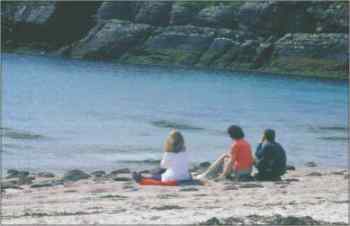|
2.1 SEA & COAST
The Sea The deep water mud habitats in sea lochs like Loch Eriboll, Loch Inchard, Loch Laxford and in Eddrachillis Bay support many species of crab and starfish as well as burrowing shrimp, nephrops, burrowing urchins and sea pens including Funiculina quadrangularis, which is rare in such relatively shallow waters. Many sea lochs also contain maerl beds, a rare habitat made up of purple encrusting calcareous algae. In favourable conditions, maerl may form reefs of loose, branching nodules. The sheltered, low-energy habitats of some of Sutherland’s inner sea lochs support a rare variation of the knotted or egg wrack Ascophyllum nodosum. In particular conditions of extreme shelter and fluctuating salinity, detached fragments of this species can grow into unattached masses at upper or mid-tide levels - the variant ecad mackaii. The main UK (and world) populations of this are The inshore waters of the North Atlantic once
offered prime fishing grounds. Common skate, cod, hake, herring, mackerel,
plaice, saithe, sole, whiting, monkfish and ling are all caught in inshore
waters around Sutherland. Occasionally, leatherback |
Beaches, dunes & machair The machair or dune grasslands of Oldshoremore, Oldshorebeg and Sheigra are amongst the richest dune areas in Britain, with over 200 different species of flowering plant growing there. Strathy Bay is another area of dune grassland rich in wild flowers, and a number of rare plants including purple oxytropis, Scottish primrose and some rare eyebright species flourish there. These plant communities co-exist with the traditional low intensity land management undertaken by local crofters, and provide important habitats for rare species such as the great yellow bumblebee. Sutherland has some beautiful and unspoilt beaches. At Sandwood Bay a relatively undisturbed sand dune and machair bar impounds the Sandwood loch, and the peaty soils of the surrounding area are influenced by blown sand. Balnakeil beach is another beautiful area, backed by dunes, coastal grasslands and steep cliffs on the narrow headland of Faraid Head. There are small areas of salt marsh located around the county, for example at Durness, Laxford Bridge, Loch Fleet and the inner Dornoch Firth. The headland between the Rivers Naver and Borgie forms a unique raised beach where, due to the severe exposure, mountain plants grow almost down to sea level. This area also contains some important archaeological sites, and Torrisdale Bay contains large sand dune systems that are particularly evident at Invernaver. During the winter months, large flocks of wading
birds such as oystercatcher, ringed plover and dunlin can be seen feeding
at low tide in areas such
Coastal cliffs & heaths Rock ledge and crevice plant communities may contain thrift, Scots lovage, sea mayweed and roseroot. From May to August our cliffs are home to a collection of nesting seabirds including puffins, fulmars, kittiwakes, razorbills, guillemots, black guillemots, cormorants and shags. Some of the best remaining examples of maritime heath in Scotland occur along the coastline of Sutherland at places such as Cape Wrath, Ben Hutig, Strathy Point and Littleferry. On the east coast, the Ferry Links, Littleferry and Cuthill Links are nationally important heathland sites for lichens. The limestone outcrops by Loch Eriboll have greatly influenced the vegetation, which has developed extensive grasslands and coastal heaths dominated by mountain avens. Other mountain plants such as moss campion and purple saxifrage occur on these northern-most coasts almost down to sea level because of the suitable bedrock and severity of the weather. The western cliffs support a suite of nationally rare mosses and liverworts, listed below. The tops of the sea cliffs have developed a coastal heath dotted with spring squill and Scottish primrose. |
